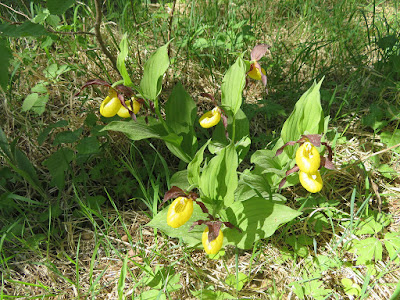Cypripedium calceolus can be found in northern England and Scandinavia, eastern France, NE Spain, Germany, N Italy and Eastern Europe eastwards to European Russia, Siberia, N Sakhalin, Korea, NE China (Heilongjiang, Kirin and Inner Mongolia) and Japan (Rebun Island).
Cypripedium calceolus also called as The Limestone Loving Cypripedium, Cypripedium boreale, Cypripedium ferrugineum, Cypripedium atsmori, Cypripedium cruciatum, Cypripedium alternifolium, Cypripedium microsaccos, is a species of the genus Cypripedium. This species was described by Carl Linnaeus in 1753.
IDENTIFY CYPRIPEDIUM CALCEOLUS ORCHID PLANT
Cypripedium calceolus can be found in northern England and Scandinavia, eastern France, NE Spain, Germany, N Italy and Eastern Europe eastwards to European Russia, Siberia, N Sakhalin, Korea, NE China (Heilongjiang, Kirin and Inner Mongolia) and Japan (Rebun Island). It has typical habitats that include open woodland, scrub under conifers, forest margins, grasslands, forests with oak, hornbeam, beech, spruce and pine and ravine forests, thermophile woodland fringes, Picea taiga woodland from sea level up to 2100 meters altitude.
It is a small to medium sized, cold growing terrestrial growing to 60 cm tall with a pubescent stem carrying 3 to 5, oval-lanceolate, slightly plicate, obtuse leaves. The leaves can reach 18 cm in length and 9 cm in breadth.
The Limestone Loving Cypripedium blooms in the spring and summer on a terminal, 35 cm long, 1 to 2, rarely 3, flowered inflorescence. The sepals and petals are maroon (rarely green) and often spirally twisted. The sac of the slipper-like lip is yellow, and spotted inside with red. The flowers can have green or yellow, rather than maroon, sepals and petals and a white, rather than a yellow, lip.
CYPRIPEDIUM CALCEOLUS ORCHID PLANT CARE AND CULTURE
Cultural information should only be used as a guide, and should be to be adapted to suit you. Your physical location; where you grow your plants, how much time you have to devote to their care, and many other factors, will need to be taken into account. Only then can you decide on the cultural methods that best suit you and your plants.
Light:
Cypripedium calceolus is a woodland species, does not demand strong light, and prefers to be fully or partially exposed to the sun, but resist something shady areas. It is good to enjoy the sun flower cooler hours of the day, but to have some shelter and can be grown on the north side of a building. If grown in a cold frame it should be covered by shade cloth in the summer.
Temperature:
The plants can be grown outside in cold frames, and benefit from a cold winter. They are able to survive cooler temperatures throughout the year. They like daytime temperatures that range from 10°C to 18°C. They can tolerate slightly warmer temperatures, but the daily temperature shouldn't exceed 26°C as it won't tolerate it. During the nighttime, this orchid can tolerate temperatures that fall around the freezing mark of 0°C, but they do better with temperatures around 7°C.
Substrate, growing media and repotting:
Cypripedium calceolus grow very well in large pots with very loose, light, well-aerated soil. If it's possible, get a rich humus soil that'll help retain moisture and mix it with perlite to improve drainage. This plant only needs to be repotted every four or five years, and you should repot them in the spring when you see new growth starting, so it has the growing season to reestablish itself. When you repot it, you want to place the bud just below the soil's surface, but make sure you don't bury it. Finally, lightly cover it with a thin layer of fine gravel or sand to protect it from bugs.
Humidity and watering:
Cypripedium calceolus like to be moist, but they won't tolerate getting soaked on a constant basis. You don't want to allow them to dry out either, and you should water them twice a week during the growing months from April through October. From October through the end of May, these orchids go into a dormant period where they require less water and fertilizer. You can cut back your watering to once a week with periodic checks to ensure they're staying moist. They like humidity levels around 50%.
Fertilizer:
As soon as you notice new growth beginning at the start of the growing period, you should feed your orchid every 10 days with a diluted half strength balanced fertilizer. You can alternate this balanced fertilizer with a seaweed-based fertilizer every other feeding. When your orchid goes dormant, you can stop fertilizing them throughout their dormant period. They won't need it until you start to see new growth in the spring, and then you can resume feeding your orchid every 10 days.

















I am in Canada Zone 2-3 I have had a cypripedium in my garden since I moved there 18 years ago. It did not bloom last year, nor is it blooming this year . Lots of leaves but no stalks.
DeleteThe tree beside it blew down 2 years ago, but there are still saplings there. Coudl this be the reason the cyp is not blooming. I might add there is a wild patch near by in a ditch but they are not blooming either. We had a very late spring. I would be grateful for any advice. Thank you
Maybe its cause of the period of rest or the soil. Try to repot its in the spring and give your plant a good rest next winter. You can use high-phosphoric fertilizer to stimulate flowering.
Delete